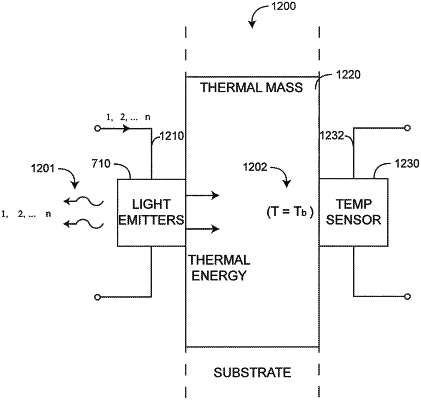| CPC G16H 40/67 (2018.01) [A61B 5/0022 (2013.01); A61B 5/0205 (2013.01); A61B 5/02416 (2013.01); A61B 5/0261 (2013.01); A61B 5/0295 (2013.01); A61B 5/14532 (2013.01); A61B 5/14546 (2013.01); A61B 5/1455 (2013.01); A61B 5/14551 (2013.01); A61B 5/14552 (2013.01); A61B 5/1495 (2013.01); A61B 5/6815 (2013.01); A61B 5/6826 (2013.01); A61B 5/6829 (2013.01); A61B 5/6832 (2013.01); A61B 5/6838 (2013.01); A61B 5/7221 (2013.01); A61B 5/7246 (2013.01); A61B 5/7275 (2013.01); A61B 5/7278 (2013.01); A61B 5/7405 (2013.01); A61B 5/742 (2013.01); A61B 5/746 (2013.01); A61B 5/7475 (2013.01); G16H 10/40 (2018.01); A61B 1/00 (2013.01); A61B 5/02427 (2013.01); A61B 2562/08 (2013.01); A61B 2562/085 (2013.01); A61B 2562/185 (2013.01); A61B 2562/222 (2013.01); Y10S 439/909 (2013.01)] | 7 Claims |

|
1. A physiological monitoring device comprising:
at least two groups of LEDs coupled to a substrate, the at least two groups of LEDs configured to emit light of at least two different wavelengths, wherein each group comprises at least a plurality of LEDs, wherein a thermal mass of the substrate stabilizes a bulk temperature of the at least two groups of LEDs;
at least one detector configured to detect at least a portion of the light emitted from the at least two groups of LEDs after at least a portion of the light has been attenuated by tissue, the at least one detector configured to output at least one signal responsive to the detected light;
a substrate temperature sensor coupled to the substrate, wherein the substrate temperature sensor is configured to measure a temperature of the substrate and wherein the temperature of the substrate is responsive to the bulk temperature of the at least two groups of LEDs; and
at least one hardware processor configured to:
control an operating condition of the physiological monitoring device based on the bulk temperature of the at least two groups of LEDs; and
process one or more signals responsive to the outputted at least one signal to determine a physiological parameter of a user responsive to the one or more signals.
|